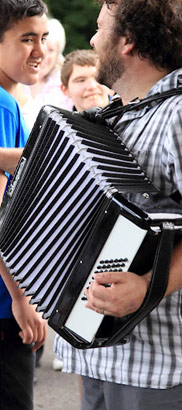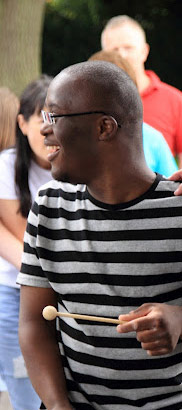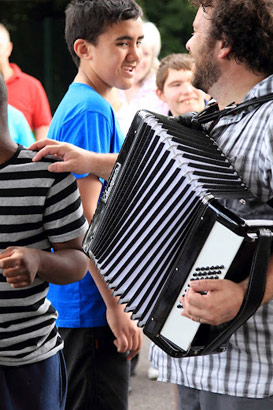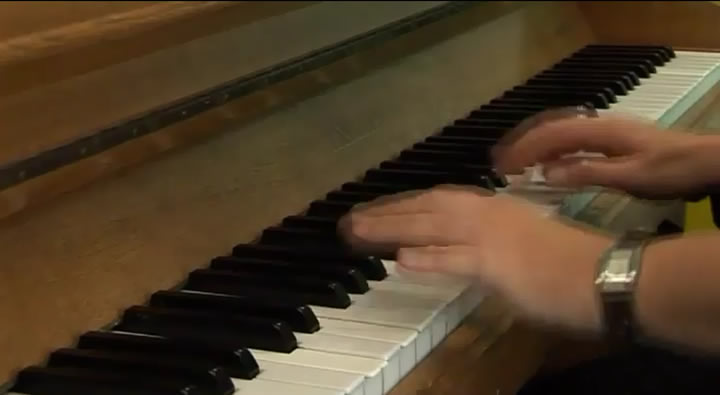
Adam Ockleford's work, Sounds of Intent (Ockleford, 2008), will be of considerable interest to all those working (or indeed
thinking of working) in this field. Originally designed to enable children with PMLD to access music, this has now developed a wider scope and includes those with severe and complex
learning difficulties.
Sounds of Intent 'maps' musical behaviour and development in children with complex needs. It divides musical expression into
three distinct but interdependent areas: reactive, pro-active and interactive. It seeks to offer a developmental map that
is both non-linear and non-hierarchical.
It's a process-based way of teaching that encourages the child to take responsibility for their own learning by emphasising
an individual approach to musical expression. This makes for a powerful learning tool as it's intrinsically motivating - the
child is 'guided' along at his/her own pace and direction.

The work of Wendy Prevezer (2000) and especially Margaret Corke (2002, 2011) has been used to develop an interesting musical
variation of Intensive Interaction.
This is based on the principles of Intensive Interaction. Exponents argue that:
- It's suitable for all children with SLD/PMLD/CLDD, who are at the earlier stages of communicative development;
- It allows and encourages valid musical experiences;
- It allows and encourages personal interactions;
- It's a motivational communicative tool;
- It doesn't require musical ability on the part of the teacher (try using a microphone as a musical instrument, for example);
- It's a lot of fun.

Corke (2002, 2011) argues that voluntary, active input from the child is essential for growth and learning to take place.
She argues for a move away from traditional music sessions where only conventional tunes are played and a move towards sessions
where we use music to teach interactive and communicative skills.
Musical interaction then becomes: a means of allowing and encouraging valid musical experiences; a means of allowing and encouraging
personal interactions; and a motivational communicative tool. Musical ability on the part of the teacher helps, but is not
essential as long as all parties are having fun.
Pat Lloyd has written and arranged a number of songs for use in interactive group work (Lloyd, 2008) with children with severe,
profound and complex learning difficulties that can be considered more 'conventional'.

Crosby (2002) gives some useful fundamental principles for using music as a communicative learning opportunity which could be applied to any of the arts. These are:
- Keep it fun and playful;
- Wait – for a response, and wait before you jump in to help. Give the opportunity to respond;
- Remember there is a difference between co-active playing and coercive playing;
- Banging the child's hand against a drum is not the child being creative, it's the adult controlling the child. Be sensitive in your prompting;
- Start from the child's lead and develop activities accordingly;
- Accept any response as intentional and worthwhile. Use it creatively within the music;
- Read the child's non-verbal signals carefully;
- Make the music fit the child, not the other way round.

Musical interaction requires:
- Interactors – through face, body language and voice;
- Social interaction games – such as burst-pause; anticipation games; rough and tumble; give and take; physical activities (eg clapping, tickling, rocking, rowing, peek-a-boo, hide and seek, throwing things backward and forward);
- Music – though not necessarily what we might consider to be conventional music with recognisable tunes; anything which makes sounds, including voices, is sufficient.
- Structure to the lesson – children gathered in a circle; a musical introduction; a 'hello song'; time for small group, peer and one-to-one interactions; a 'goodbye song'.
Watch the video clip where teachers use music throughout a storytelling session to introduce the story, as well as establish characters and moods.
For more information, visit the website, Sounds of intent

Corke, M. (2002) Approaches to Communication through Music, London: David Fulton.
Corke, M. (2011) Using Playful Practice to Communicate with Special Children, London: David Fulton/Nasen.
Crosby, K. (2002) Communication through Music for Pupils with Profound and Multiple Learning Difficulties, The SLD
Experience.
Lloyd, P. (2008) Let's all Listen: Songs for Group Work in Settings that Include Students with Learning Difficulties and
Autism, London: Jessica Kingsley.
Ockleford, A. (2008) Music for Children and Young People with Complex Needs, Oxford: Oxford University Press.
Preveezer, W. (2000) Musical interaction and children with autism in Powell, S. (ed) Helping Children with Autism To Learn,
London: David Fulton.
